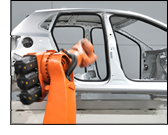 The Rules of the Road have changed, literally, with the bankruptcy filings of Chrysler and GM. Their restructurings have moved through the bankruptcy court at a dizzying pace. The sale of substantially all of Chrysler’s assets to Fiat was approved in June, and in mid-July, a judge approved the sale of GM’s most-valuable assets to a new company, majority owned by the federal government. These reorganizations are structured as asset sales to new entities "free and clear" of tort claims arising from vehicles manufactured and sold pre-bankruptcy.
The Rules of the Road have changed, literally, with the bankruptcy filings of Chrysler and GM. Their restructurings have moved through the bankruptcy court at a dizzying pace. The sale of substantially all of Chrysler’s assets to Fiat was approved in June, and in mid-July, a judge approved the sale of GM’s most-valuable assets to a new company, majority owned by the federal government. These reorganizations are structured as asset sales to new entities "free and clear" of tort claims arising from vehicles manufactured and sold pre-bankruptcy.
Through this process, the automakers are eliminating thousands of dealers and leaving tort claimants to recover just pennies on the dollar through the bankruptcy court because Chrysler and GM for all intents and purposes were self-insured for products defect claims.
Chrysler already has obtained bankruptcy court approval of its "free and clear" sale that purports to prohibit the assertion of all current and future claims involving a vehicle it sold pre-bankruptcy against "new" Chrysler. GM’s treatment of tort claims is somewhat different. Bowing to political pressure, "new" GM has agreed that it would accept liability for all claims involving GM cars that were sold prebankruptcy, so long as the accident occurred after the June 1, 2009 filing of GM’s bankruptcy petition. As with Chrysler, however, claims arising from pre-bankruptcy accidents would still get paid in nearly-worthless "bankruptcy dollars."
The terms of the sale leave a large group of tort claimants and insurer subrogees largely out of luck in pursuing claims against Chrysler and GM. While claims which involve cars sold pre-bankruptcy can still be brought against "new" GM if the accident occurred after the June 1 filing of the bankruptcy petition, insurers will find that most other subrogation claims, like those of the tort claimants, will be relegated to the bankruptcy court to be processed as nearly-worthless, unsecured bankruptcy claims.
While "new" GM has accepted some liability for these types of claims, "new" Chrysler has not. Thus, it is likely that despite the terms of the bankruptcy court order which prohibits the assertion of current and future claims against Chrysler, future claimants will attempt to assert successor liability claims against "new" Chrysler. In addition to challenging this portion of the bankruptcy court’s order in Chrysler, many of these claimants will seek other sources of recovery, such as dealers and suppliers; potentially exposing their insurers to risks they did not foresee underwriting.



